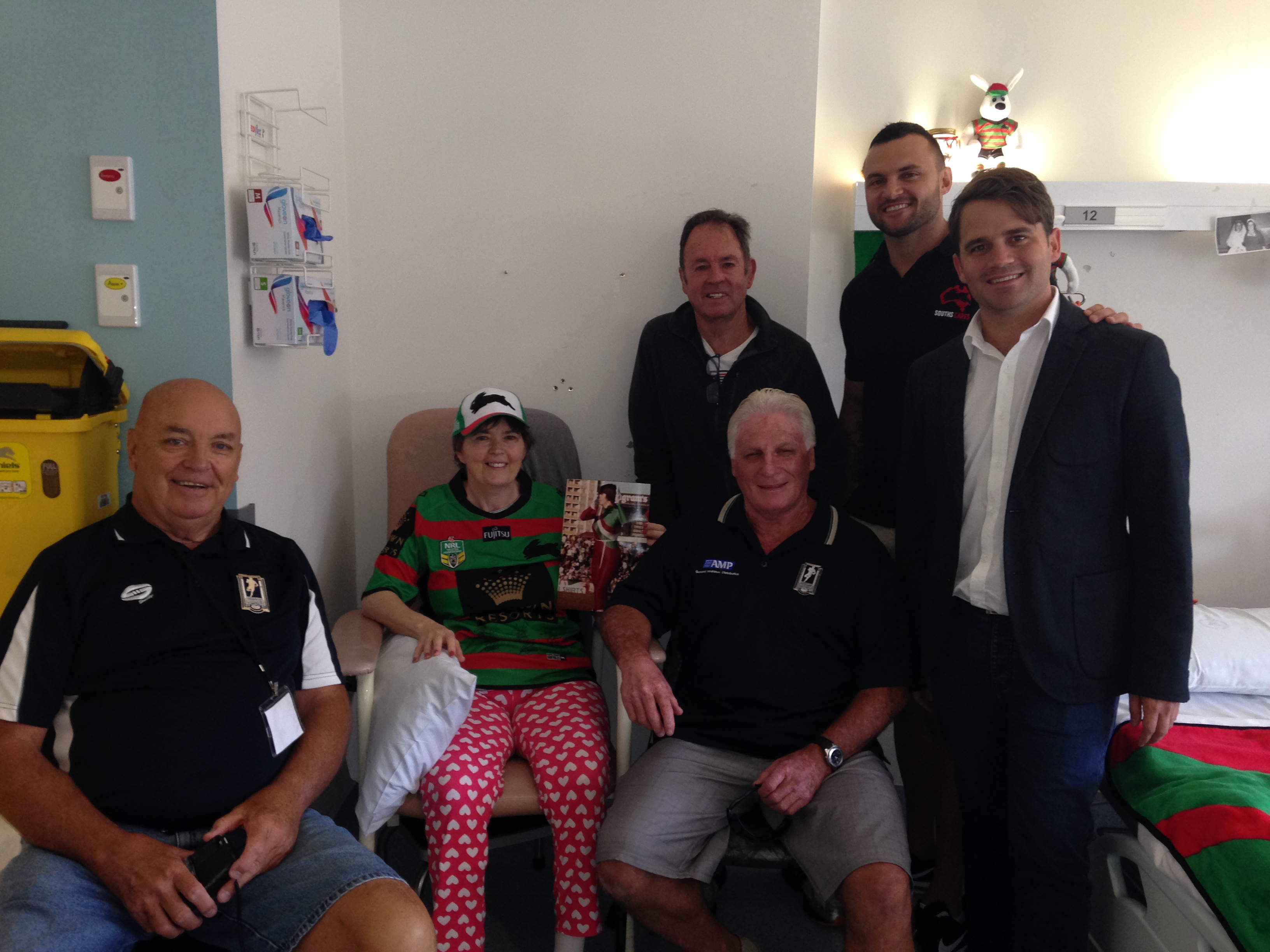A surprise welfare visit to Tracey Dakin at Campbelltown Hospital was organised by her friends Lisa Hammond and husband Darren, Kathy Stewart and Tracey’s daughter Rebekah.
Much to Tracey’s surprise South’s Care Representatives Brock Schaeffer, and former player Beau Champion attended along with John Peard, Bob McMillan and Alan Webb Welfare Officers from Sydney Metro. Tracey’s face lit up when Beau walked into the room. Beau presented Tracey with a signed South Sydney Jumper and Cap, she was also given a pink Men of League Foundation Ladies Polo shirt.

We were able to spend over an hour with Tracey and her wish is to be able to attend one more South’s game – this is to be organised subject to her being well enough to attend.
In September 2005, Tracey and her family were involved in a traumatic car accident that left her with terrible injuries. This involved a lengthy hospital stay, rehabilitation and lasting physical disability and emotional scars for all of them.
In June 2014, after separation from her partner, Tracey moved into her own home and struggled to get back on her feet for the sake of her three children. Not long after, she started to experience headaches that wouldn’t go away and unusual dizzy spells. A brain CT revealed a meningioma – a tumour in the meninges, the membranous layers surrounding the brain. An operation was needed. As with any brain surgeries there was the risk of brain damage, stroke or death but the surgery was performed to remove as much of the tumour as possible, taking care to avoid vital blood vessels in the brain.
Unfortunately, the tumour regrew and a second operation was performed in July 2015, to remove the extra growth and she had radiation to kill the remaining tumour.
Tracey felt she would finally be on the road to recovery but in May 2015 Tracey had a fall at home and broke her hip. Her recovery and rehab was unusually slow, spending 4 weeks in hospital. The doctors decided to CT her brain again, thinking the fall and her slow recovery may be related to her meningioma.
The CT revealed that whilst the radiation had worked on the first tumour further meningioma were growing outside the radiation area. A third operation was conducted November 2015, with greater physical effects than the previous two operations. Tracey was now experiencing arm and leg tremors and increased physical weakness.
Back home her children tried helping her as much as they could, whilst Tracey struggled to give the children a normal home life despite her physical limitations.
After three brain operations and radiation therapy the doctors realised that the tumours would just keep growing back. Tracey was hoping to begin an experimental chemotherapy treatment called Lutate.
Lutate therapy in NSW is used when there is progression of NETs (neuroendocrine tumours) disease and existing growth-inhibiting therapies are no longer effective. Peptide Receptor Radionuclide Therapy (PRRT) or Lutate Therapy is a specific therapy suitable for some but not all NETs patients, delivered by Nuclear Medicine departments. In the majority of cases, Lutate stabilises or improves disease that has previously been progressive, and some patients achieve remission.
But, only one month after her third operation Tracey again experienced arm and leg tremors. A CT revealed the remaining tumour had doubled in size in four weeks. Her meningioma was now classified as an extremely rare and aggressive Grade 3 malignant meningioma.
This put Lutate on hold, whilst a fourth operation was performed in February 2016. This operation has left Tracey unable to walk, use her Right arm or to care for herself or even sit up properly. Spinal fluid has been leaking out of the sutures in her head.
Tracey’s children have been informed by Tracey’s professor of the seriousness of her condition. They are broken.
Lutate therapy has finally begun. The problem here is the doctor doesn’t know if her tumour will advance too quickly before Lutate has the chance to work – Lutate begins to work after about 8 weeks, but many 8 week courses may be undertaken. The doctors aren’t even sure if Tracey’s tumour will respond to the Lutate at all.
Tracey, our dear friend, has been given only months at most, perhaps weeks, to live. Each Lutate treatment will cost Tracey $4,000 every 8 weeks (the treatment appallingly not funded by the government for her rare type of tumour).
Lutate is offered in other states as a course of treatment for tumours, but in NSW it is only used as a last resort. Tracey wasn’t informed of Lutate until the disease was out of control. Apparently NSW patients have to travel to other states or even countries like America if they want Lutate treatment straight away, even though Lutate has been successful in slowing the growth of some tumours. You can’t help but wonder if Tracey’s story could’ve been different if Lutate treatment had been offered to her sooner.
Tracey’s family needs all the financial support they can get. A My Cause account has been opened to help ease the financial burden for her family and provide some financial security for her kids. The link for Tracey is https://www.mycause.com.au/share/121608
Alan Webb – Welfare Officer, Sydney Metro
16 March 2016








